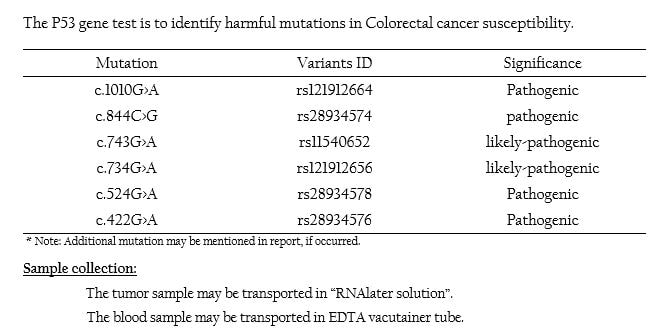P53 Mutation Panel
p53 overview:
- p53 is a tumour suppressor gene that play a vital role in maintaining the genomic stability and tumour prevention.
- There are three major functions that are regulated by p53: DNA repair, apoptosis and cell cycle.
- In normal cells without stress or stimuli, the activity of p53 is very low. Upon stress or multiple stimuli like chemotherapeutic agents, ionizing radiations or oncogenic stimuli can activate the p53 through a series of posttranslational modifications. In response to these stimuli p53 undergoes different changes and this activation could induce different affects depending the nature of the stimuli[1&2].
- p53 is a transcription factor involved in the control of G1/S and G2/M phase transition, in DNA repair, and in induction of senescence, apoptosis, autophagy, mitotic catastrophe, and angiogenesis[3]
- p53 is also responsible for regulating various metabolisms like glycolysis[4]
- They key regulator of p53 gene is MDM2 and it has the ability to degrade the p53 protein by proteasome degradation pathway.
- P53 regulates three major processes by controlling various target genes. They are: in DNA repair it regulates p53R2 and PIG3 genes, growth arrest is regulated by p21, Gadd45 and 14-3-3σ genes and in apoptosis it regulates Bax, Apaf-1 and PUMA genes [5, 6&7]
- TP53 is the most frequently mutated gene that has been reported in almost all human cancers.
- When p53 mutates, its functions are altered as well, hence there will be a disturbance in the normal routine function of the normal p53.
- Almost 50% of all human cancers has been reported the alteration of the p53 gene and its functions.
- P53 mutations can be both somatic and germline. Somatic mutation is when somatic cells (body cells except cells in reproductive system) are mutated and germline mutation is when cells (reproductive cells) are mutated.
- Somatic mutations cannot be passed on to the next generations as they are caused in the body cells. Unlike somatic mutation, germline mutations can be passed on to the next generation as the cells in the reproductive system are mutated.
- Somatic p53 mutations are found in approximately 50% of human cancer [8&9]
- Germline mutations in the TP53 gene cause a familial cancer predisposition
- The lose of tumor suppressor function, many of the p53 missense mutants actively promote cancer by acquiring gain-of-function (GOF) activities[10]
- Individuals with Li-Fraumeni syndrome (LFS) caused by germline TP53 mutations are estimated to have a 73% to 100% lifetime risk of cancer, including colorectal cancer (CRC).
- TP53 mutations are the second most common alteration in about 40% to 50 % of colorectal carcinomas. [11]
- Notably, 74% of p53 mutations are missense mutations, which results in the formation of a mutant protein.[10&12]
- There is a 90% lifetime risk for an individual to develop any type of cancer with TP53 mutation.
- In a previous study of 200 cancer patients diagnosed with TP53 mutation, 15% developed second stage cancer, 4% developed third stage cancer and 2% developed a fourth stage cancer.
- When a person is tested with TP53 mutation, the physician highly recommends regular monitoring to check the development of the cancer.
- There are research evidences that shows that monitoring plan improves the survival of individual with a TP53 mutation who did not have any signs and symptoms of cancer.
- Clinical breast examination twice a year, annual breast MRI beginning at age 20 to 25.
- He G, Siddik ZH, Huang Z, Wang R, Koomen J, Kobayashi R, et al., (2005). Oncogene, 24(18), 2929.
- Cox MLand Meek DW. (2010). Cellular Signalling, 22(3); 564–571
- Harris SL and Levine AJ. (2005). Oncogene, 24(17), 2899–2908.
- Warburg O. (1956). Science 123, 309-314.
- Levine AJ, Hu W, Feng Z. (2006). Cell Death Differ 13, 1027-1036.
- Riley T, Sontag E, Chen P, Levine A. (2008). Nat. Rev. Mol. Cell Biol. 9, 402-412.
- Vogelstein B, Lane D, Levine AJ. (2000). Nature 408, 307-310.
- Petitjean A, Mathe E, Kato S, Ishioka C, Tavtigian SV, Hainaut P, Olivier M. (2007) Hum Mutat, 28, 622-629
- Soussi T, Ishioka C, Claustres M, Béroud C. (2006). Nat Rev Cancer 6, 83-90.
- Muller PA, and Vousden KH. (2014). Cancer Cell, 25: 304-317.
- Iacopetta, B. (2003). Hum Mutat, 21: 271-276.
- Brosh R, and Rotter V. (2009). Nat Rev Cancer, 9: 701-713.

